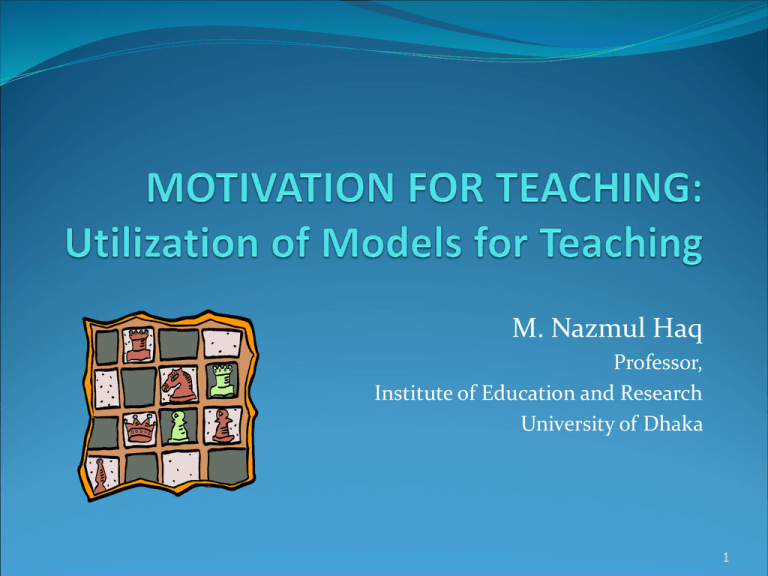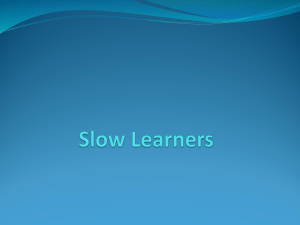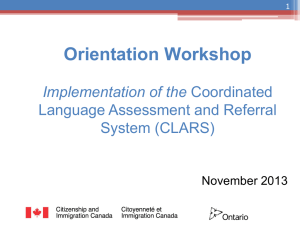Teaching and learning model-R - Tdi
advertisement

M. Nazmul Haq Professor, Institute of Education and Research University of Dhaka 1 What is education ? Education is a process of transmitting knowledge, attitude and skills to the people who are in need of it. There are two parties in education: a. Teacher b. Learner Both the parties are characterized with their own ways of dealings 2 What is the teachers expectation for education ? Control learning ? or Promote learning ? 3 Control learning provides Good students High scorers Limited ability Poor insight Low potential 4 Learning for promotion provides Quality students High scorers Unlimited ability Wider insight Higher potential 5 Teachers’ main thrust for teaching depends on their motivation for teaching 6 What is Motivation ? It is a process that generates a behaviour and leads it towards the goal. Three basic questions may clarify its nature: What causes an action ? What pushes towards particular goal? What persists the attempt to reach the goal ? 7 What causes motivation ? Some external factors: content, teaching aids, models of teaching, grades, etc. These external factors are known as extrinsic factors. Some internal factors: curiosity, interest, expectation, anticipation, success, etc. These internal factors are known as intrinsic factors. 8 Model of teaching What is a model ? A model is a system which can be copied by someone. So a teacher’s model is the way a teacher behaves in his/her pursuit. There are three models of teaching: The executive model Therapist model Liberationist model 9 Executive model This model sees the teacher as the master of the craft and he/she is responsible for learner’s progress It emphasize direct instruction and hold the responsibility of prescription Giving lectures, demonstration, suggestions etc. are the techniques of this model Makes the learners dependent on teacher 10 Therapist model This model views the teacher as highly sympathetic individual. Here teacher allows the learner to go by his/her own pace Here teacher works as passive facilitator rather than direct instructor This model is student centered and help them to construct their own materials Discover learning, cooperative learning, group discussion, apprenticeship etc. are the techniques of this model 11 Liberationist model This model views the teacher as a liberator of students’ mind by providing them with the tools and attitudes necessary for learning Here students are taught how to learn than what to learn Learners take the responsibility for their development and teacher works as catalyst Discover, projects, visits, debates, self criticism etc. are the techniques of this model 12 Models of learners Learner’s model is the way a learner behaves in his/her pursuit. There are two types: Acquisition model Where learners largely accumulate information This model sees teacher as instructor Participation model Where learners largely participates in the process of learning and develop their own information 13 Acquisition model This model is highly teacher centered Students largely depends on teacher’s instruction and texts Developing notes, collecting references, memorizations etc. are principle techniques of this model Learners become dependent on the text or teacher 14 Participation model Here learner is independent of teacher and the text Learner discover and construct his/her own information Learners are responsible for their learning Analyzing facts, doing projects, writing journals, prepare materials etc. are principle techniques of this model 15 How to increase motivation Create favourable attitude Tap students’ interest Arouse curiosity Address learners’ needs Maintain positive emotional climate Reinforce appropriate behaviours Enhance learners’ expectation Keep the anxiety to minimum level 16 Some possible applications of motivation Make the classroom and lesson interesting: Use puzzles, games, and simulations Try new arrangement of the room Introduce a lesson with music or relevant poster Relate class work with field trip or guest speaker or new events 17 Some possible applications of motivation Have sufficient chance to fulfill students’ needs: Provide some time for interaction with friends When a work is anxiety provoking (oral report, major tests) have students to work in group 18 Some possible applications of motivation Make the classroom a pleasant and safe place: Provide tutor for students who are falling behind Choose assignment which is easy for weak students Do not allow ridicule a student by other students 19 Some possible applications of motivation Address the needs of backward students: Give un-graded assignment for improvement Have individual conference to discuss progress 20 Some possible applications of motivation Help students to take responsibility for success and failure: Take responsibility of your own mistakes and discuss it with students Invite guest speakers who are willing to speak about their success and failure 21 Some possible applications of motivation Encourage students to discover the connections between their efforts and accomplishment: After doing a complex assignment ask students to discuss it was done Discuss reasons for particular success and failure 22 Some possible applications of motivation Help students to set reasonable short-term goals: Encourage students to set low goals Suggest alternative in case of unrealistic high goals 23 If you want to be an effective teacher follow these points Know about your own model Be clear to yourself, why you follow that model Switch your model if necessary Do not imitate others without understanding Be a good student for your teaching Do not teach unless you are motivated Quit the job if your are not satisfied 24 25







